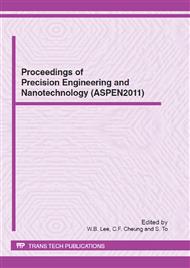[1]
M. Gurr, Y. Thomann, M. Nedelcu, R. Kübler, L. Könczöl, R. Mülhaupt, Novel acrylic nanocomposites containing in-situ formed calcium phosphate/layered silicate hybrid nanoparticles for photochemical rapid prototyping, rapid tooling and rapid manufacturing processes , Polymer, 51 (2010).
DOI: 10.1016/j.polymer.2010.08.026
Google Scholar
[2]
J.H. Underwood, Imaging properties and aberrations of spherical optics and nonspherical optics, Vacuum Ultraviolet Spectroscopy (2000) 145-181.
DOI: 10.1016/b978-012617560-8/50010-4
Google Scholar
[3]
T. Yamaguchi, K. Negishi, T. Ono, H. Torii, M. Dogru, K. Yamaguchi, K. Ohnuma, K. Tsubota, Feasibility of spherical aberration correction with aspheric intraocular lenses in cataract surgery based on individual pupil diameter, J. Catara. CT Refr. Surg. 35 (2009).
DOI: 10.1016/j.jcrs.2009.05.031
Google Scholar
[4]
E. Heynacher, Aspheric optics. How they are made and why they are needed, Phys. Technol. 10 (1979) 124–131.
DOI: 10.1088/0305-4624/10/3/i01
Google Scholar
[5]
M.J. Chen, D. Li, S. Dong, Research on a large depth-to-diameter ratio ultra-precision aspheric grinding system, J. Mat. Process. Tech. 129 (2002) 91-95.
DOI: 10.1016/s0924-0136(02)00582-4
Google Scholar
[6]
T. Kuriyagawa, M.S. S. Zahmaty, K. Syoji, A new grinding method for aspheric ceramic mirrors, J. Mat. Process. Tech. 62 (1996) 387-392.
DOI: 10.1016/s0924-0136(96)02440-5
Google Scholar
[7]
H.S. Kim, E.J. Kim, B.S. Song, Diamond, , J. Mat. Process. Tech. 146 (2004) 349-355.
Google Scholar
[8]
C.C. Kuo, C.Y. Lin, X. Z Wu, Development of an adjustable mold box for making silicone rubber mold, Proceeding of the 2010 IEEE International Conference on Industrial Engineering and Engineering Management; Macau, China, 7-10 (2010) 762-766.
DOI: 10.1109/ieem.2010.5675606
Google Scholar
[9]
F.A. Almeida, A.J.S. Fernandes, F.J. Oliveira, R.F. Silva, Semi-orthogonal turning of hardmetal with CVD diamond and PCD inserts at different cutting angles, Vacuum 83 (2009) 1218-1223.
DOI: 10.1016/j.vacuum.2009.03.029
Google Scholar
[10]
S. Chung, Y. Im, H. Kim, H. Jeong, D. A. Dornfeld, Evaluation of micro-replication technology using silicone rubber molds and its applications , Int. J. Mach. Tool. Manu. 43 (2003) 1337-1345.
DOI: 10.1016/s0890-6955(03)00164-0
Google Scholar


